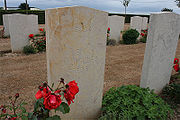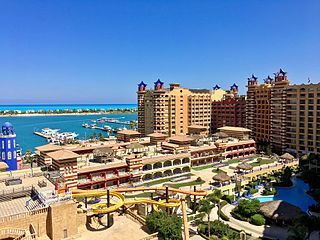
El Alamein is a town in the northern Matrouh Governorate of Egypt. Located on the Mediterranean Sea, it lies 106 kilometres (66 mi) west of Alexandria and 300 kilometres (186 mi) northwest of Cairo.

The Commonwealth War Graves Commission (CWGC) is an intergovernmental organisation of six independent member states whose principal function is to mark, record and maintain the graves and places of commemoration of Commonwealth of Nations military service members who died in the two World Wars. The commission is also responsible for commemorating Commonwealth civilians who died as a result of enemy action during the Second World War. The commission was founded by Sir Fabian Ware and constituted through Royal Charter in 1917 as the Imperial War Graves Commission. The change to the present name took place in 1960.
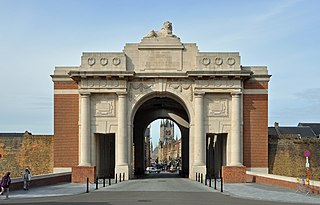
The Menin Gate, officially the Menin Gate Memorial to the Missing, is a war memorial in Ypres, Belgium, dedicated to the British and Commonwealth soldiers who were killed in the Ypres Salient of World War I and whose graves are unknown. The memorial is located at the eastern exit of the town and marks the starting point for one of the main roads that led Allied soldiers to the front line.

Tyne Cot Commonwealth War Graves Cemetery and Memorial to the Missing is a Commonwealth War Graves Commission (CWGC) burial ground for the dead of the First World War in the Ypres Salient on the Western Front. It is the largest cemetery for Commonwealth forces in the world, for any war. The cemetery and its surrounding memorial are located outside Passendale, near Zonnebeke in Belgium.

The Air Forces Memorial, or Runnymede Memorial, in Englefield Green, near Egham, Surrey, England is a memorial dedicated to some 20,456 men and women from air forces of the British Empire who were lost in air and other operations during World War II. Those recorded have no known grave anywhere in the world, and many were lost without trace. The name of each of these airmen and airwomen is engraved into the stone walls of the memorial, according to country and squadron.

The Arras Flying Services Memorial Commonwealth War Graves Commission war memorial in the Faubourg d'Amiens Cemetery, Arras, France. The memorial commemorates nearly 1,000 airmen from forces of the Commonwealth who were killed on the Western Front during World War I and who have no known grave. The memorial was designed by Edwin Lutyens, sculpted by William Reid Dick and unveiled by Hugh Trenchard, 1st Viscount Trenchard, Marshal of the Royal Air Force on 31 July 1932.
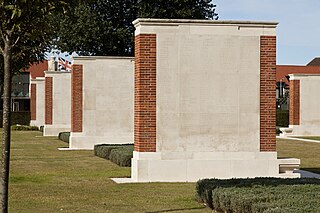
The Dunkirk Memorial is a Commonwealth War Graves Commission memorial to the missing that commemorates 4,505 missing dead of the British Expeditionary Force (BEF), most of whom fell prior to and during the Battle of Dunkirk in 1939 and 1940, in the fall of France during the Second World War.
Philip Dalton Hepworth was a British architect. He studied in both the UK and France, at the Architectural Association School of Architecture and the École des Beaux-Arts, and returned to work as an architect after serving in the First World War. He rose to prominence in the 1930s, featuring in a book by architectural critic Trystan Edwards and winning the commission in 1932 to design Walthamstow Town Hall, which was eventually completed in 1942. Another civic building of this period was Wiltshire County Hall at Trowbridge. He also designed a handful of private houses, including Pemberley, in Loughton, 1936. He lived in Zoffany House in Strand-on-the-Green, Chiswick, London, from 1936.

Banneville-la-Campagne War Cemetery is a Second World War cemetery of Commonwealth soldiers located close to the commune of Banneville-la-Campagne, 11 km (6.8 mi) east of Caen, Normandy, France. The graveyard contains 2,175 graves of which 140 are unidentified The cemetery is maintained by the Commonwealth War Graves Commission.
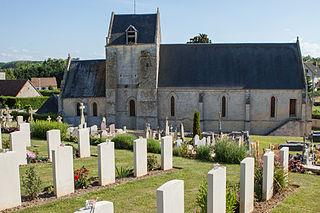
Brouay War Cemetery is a Second World War cemetery of Commonwealth soldiers in France, located between Caen and Bayeux, Normandy. The cemetery contains 377 graves, of which 7 are unidentified. The cemetery is adjacent to the commune's graveyard.
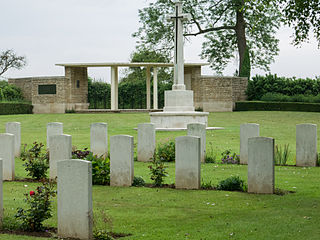
Cambes-en-Plaine War Cemetery is a Second World War cemetery of Commonwealth soldiers in France, located seven km northwest of Caen, Normandy. The cemetery contains 224 graves of which one is unidentified.

Fontenay-le-Pesnel War Cemetery is a Second World War cemetery of Commonwealth soldiers in France, located 16 km west of Caen, Normandy. The cemetery contains 461 commonwealth graves and 59 German graves.

Hermanville War Cemetery is a Second World War cemetery of Commonwealth soldiers in France, located 13 km north of Caen, Normandy. The cemetery contains 1,003 commonwealth war graves.

Hottot-les-Bagues War Cemetery is a British Second World War cemetery of Commonwealth soldiers in France, located 15 km south-west of Bayeux, Normandy. The cemetery contains 1,005 commonwealth war graves and 132 German war graves.
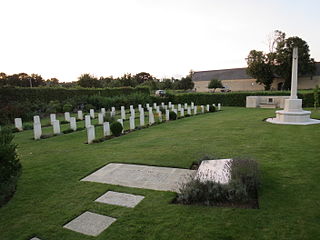
Jerusalem War Cemetery is one of the smallest Second World War cemetery of Commonwealth soldiers in Normandy, France. It is located between Bayeux and Tilly-sur-Seulles, close to the commune of Chouain. The cemetery contains 46 Commonwealth war graves, 1 Czech grave, and 1 unknown British grave.

La Délivrande war cemetery is a Second World War cemetery of Commonwealth soldiers in France, located 14 km (8.7 mi) north of Caen, Normandy. The cemetery contains 943 commonwealth war graves and 180 German war graves.

Ryes War Cemetery is a Second World War cemetery of Commonwealth soldiers located close to the commune of Bazenville, 8 km (5.0 mi) east of Bayeux, Normandy, France. The graveyard contains 653 Commonwealth war graves, one Polish and 335 German war graves. The cemetery is maintained by the Commonwealth War Graves Commission.
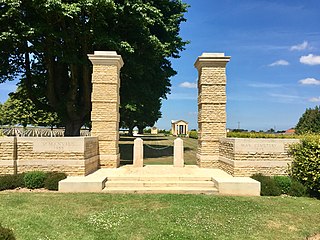
Saint-Manvieu War Cemetery is a British Second World War cemetery of Commonwealth soldiers in France, located 10 km west of Caen, Normandy. The cemetery's designation often uses the nearby commune of Cheux but the graveyard is actually closer to the commune of Saint-Manvieu-Norrey. The graveyard contains 1,627 Commonwealth war graves and 555 German war graves. The cemetery is maintained by the Commonwealth War Graves Commission.

Saint-Charles-de-Percy War Cemetery is a British Second World War cemetery of Commonwealth soldiers located 1 km (0.62 mi) west of the village of Saint-Charles-de-Percy, some 44 km (27 mi) south-west of Caen in Normandy. The cemetery contains 703 identified Commonwealth war graves and is the southernmost British cemetery in Normandy.
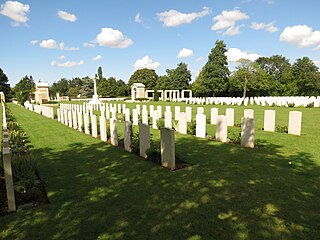
Tilly-sur-Seulles War Cemetery is a British Second World War cemetery of Commonwealth soldiers located in the village of Tilly-sur-Seulles, some 13 km (8.1 mi) south of Bayeux in Normandy. The cemetery contains 990 Commonwealth burials and 232 German graves.












